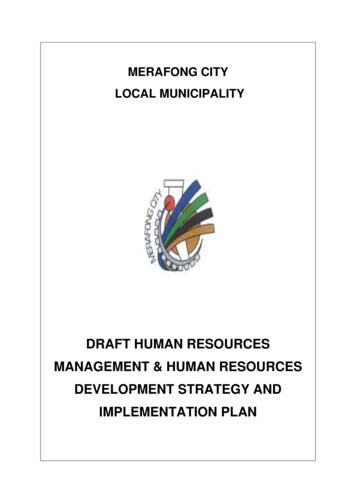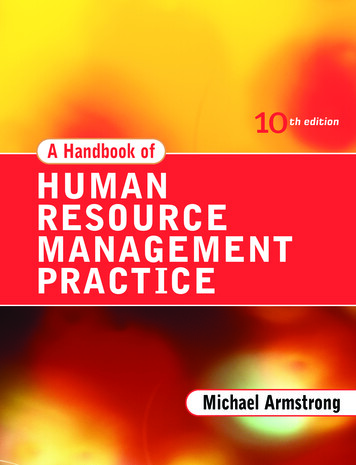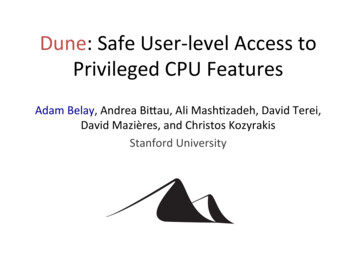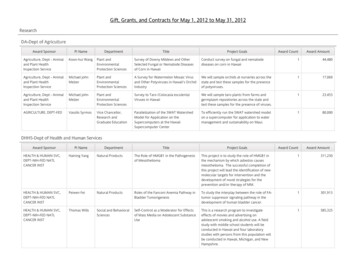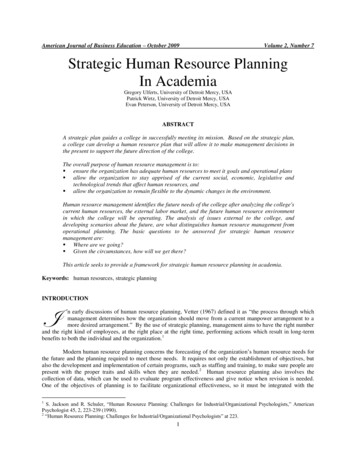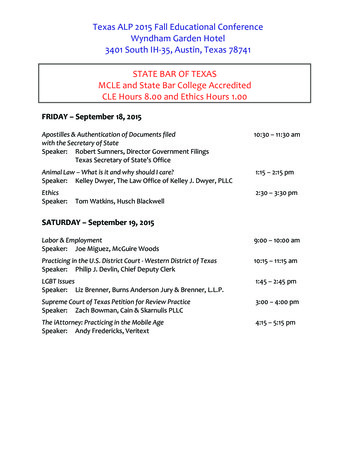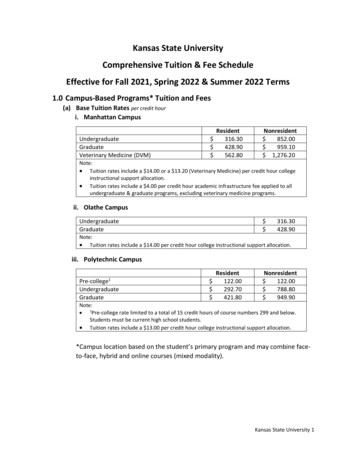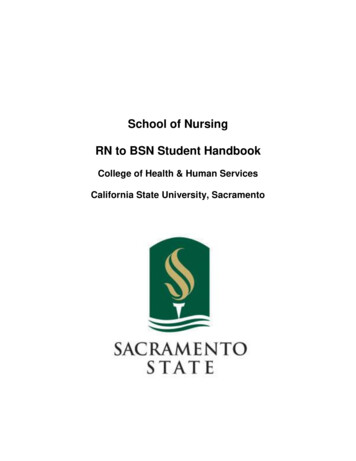
Transcription
School of NursingRN to BSN Student HandbookCollege of Health & Human ServicesCalifornia State University, Sacramento
TABLE OF CONTENTSI. INTRODUCTIONII. SCHOOL OF NURSING MISSION, PURPOSES, AND PHILOSOPHYIII. BACCALAUREATE STUDENT LEARNING OUTCOMESIV. CURRICULUM PATTERNSA. RN to BSN Full and Part-Time Patterns and ABC Program PatternV. ENROLLMENTVI. ADVISINGA. AcademicB.C.D.E.VII.ClinicalFinancial AidScholarshipsEmergency FundsPROGRAM REQUIREMENTSClearance DeadlinesA. Drug & Alcohol ScreenB. Criminal Background CheckC. Immunization RequirementsD.E.F.G.CPR CertificationProfessional Liability InsurancePersonal Health InsuranceAutomobile InsuranceH. Non-uniform Professional AttireI. TravelJ. Latex AllergiesVIII.POLICY FOR THE CONTROL OF INFECTIOUS DISEASESIX. FEESX. GRADING/REPEAT COURSE POLICIESA.B.C.D.Examination PoliciesTesting PolicyGrading – Theory, Clinical and LaboratoryRepeating Required Nursing CoursesXI. ADD/DROP/WITHDRAWAL POLICIESSchool of Nursing – RN to BSN Handbook5/16/19i
XII.TECHNOLOGYA. Use of Technology in the ClassroomB. Policy Statement Regarding the Use of Social MediaXIII.ORGANIZATIONSA. California Nursing Students’ Association (CNSA) / National Student Nurses’ Association(NSNA)B. American Assembly for Men in Nursing (AAMN), Sacramento Valley ChapterC. Sacramento State Alumni Association, Nursing ChapterD. Sigma Theta Tau International Nursing Honor Society, Zeta Eta Chapter at LargeE. Associated Students, Inc. (ASI)XIV.REGISTRATION, ATTENDANCE, AND LEAVES OF ABSENCES/SPLIT SEMESTERA.B.C.D.E.XV.Registration for the Generic BSN Student and LVN to RN StudentAttendanceMake Up PoliciesLeave of Absence (LOA) RequestsEmergency Leave of AbsenceSCHOOL OF NURSING COMMITTEES WITH STUDENT REPRESENTATIONXVI.STUDENTS RIGHTS AND RESPONSIBILITIES/UNIVERSITY AND SCHOOL OF NURSINGPOLICIESA.B.C.D.E.F.G.H.I.Student Rights Appeal Process / Complaint Policy and ProceduresStudent Grievance ProceduresSexual Harassment PolicyGrade Appeal ProcedureState Information Practices ActRepeat Grade Replacement PetitionsPetition to Add/Drop/Withdraw from CoursesPolicy Statement of Students Impaired by Chemical Dependency or Mental IllnessAcademic DishonestyXVII. STUDENT CODE OF CONDUCTA.B.C.D.E.Introductory StatementNational Student Nurses’ Association, Inc. Code of ConductCalifornia State University, Sacramento Student Conduct CodeHornet Honor CodeClosingXVIII. STUDENT RESPONSIBILITIES IN FACULTY EVALUATIONXIX.STUDENTS REQUIRING SPECIAL ACCOMMODATIONXX.GRADUATION - GENERIC BSN STUDENTSA.B.C.D.RequirementsDeadlinesCatalog RightsGeneral Education and Upper Division RequirementsSchool of Nursing – RN to BSN Handbook5/16/19ii
E. Second Baccalaureate Degree StudentsF. Pinning CeremonyG. CommencementXXI.GRADUATION WRITING ASSESSMENT REQUIREMENTS (GWAR) / WRITING PLACEMENTFOR JUNIORS (WPJ)XXII. LEARNING RESOURCESA.B.C.D.E.F.G.H.I.J.LibraryComputer LabsStudy SpacesInstructional AreasTextbooksSkills Laboratory/Learning Resource CenterLocker RoomsStudent LoungeStudent KitchenLost or Missing PropertyXXIII. SCHOOL OF NURSING PERSONNELXXIV. ADDITIONAL EDUCATIONAL OPPORTUNITIESA. NURS 195 and NURS 199 Independent StudiesB. Credit by Examination (Challenge)XXV. SACCTXXVI. THREATS TO THE CAMPUS COMMUNITYSchool of Nursing – RN to BSN Handbook5/16/19iii
I. INTRODUCTIONEducational preparation for the role as a Registered Nurse is a shared responsibility. Faculty of theSchool of Nursing are committed to guiding students as they learn the accurate and current theoreticalknowledge as well as the necessary technical skills needed in this challenging professional role. As astudent you have the responsibility to be equally invested in your education. You can assume thisresponsibility by attending class, being prepared, paying attention, involving yourself in the class, andletting go of any preconceived notions. By doing so, you will be open to truly exploring and learning boththe science and art of nursing.The coming semesters will prepare students for their roles as a professional who will meet the everchanging health care needs of society - both a challenging and awesome responsibility. To make thisexperience both productive and positive, the Student Handbook has been designed to provide answersmany of the most frequently asked questions. Minor changes in the handbook will be highlighted eachsemester in yellow in the revised version of the handbook.Return to Table of ContentsSchool of Nursing – RN to BSN Handbook5/16/194
II. SCHOOL OF NURSING MISSION, PURPOSES, AND PHILOSOPHYA. Mission StatementThe School of Nursing prepares nurses to lead diverse individuals, families, and communities in achievingoptimal health through nursing science, collaborative practice, advocacy, and service.B. VisionThe School of Nursing (SoN) transforms health care through innovative nursing education, communitypartnerships, and policy engagement.C. ValuesWe believe that the SON serves its students and the society at large by creating an environment in whichfaculty and students pursue the knowledge of nursing practice guided by the following core values: Caring Professionalism Integrity Advocacy Collaboration Inclusion Equity LeadershipReturn to Table of ContentsSchool of Nursing – RN to BSN Handbook5/16/195
III. BACCALAUREATE NURSING STUDENT LEARNING OUTCOMESBSLO I:Synthesizes theories and concepts from the sciences, the arts, and nursing in nursingpractice.BSLO II:Interprets personal values and beliefs while respecting the values and beliefs of others.BSLO III:Synthesizes principles of leadership in the delivery of safe and efficient health care.BSLO IV:Employs effective communication strategies to improve health outcomes.BSLO V:Exemplifies the values and beliefs of professional nursing consistent with the AmericanNurses Association code of ethics.BSLO VI:Utilizes patient care technologies and information management systems to promote qualitycare delivery.BSLO VII: Translates current evidence into nursing practice to improve health outcomes.BSLO VIII: Translates current healthcare policy, finance, and regulation to improve health outcomes.BSLO IX:Utilizes principles of health promotion and disease prevention to improve population health.Return to Table of ContentsSchool of Nursing – RN to BSN Handbook5/16/196
IV. CURRICULUM PATTERNSA. CURRICULUM PATTERN: RN TO BSN (STATESIDE AND ADN to BSNCOLLABORATIVE [ABC]) STUDENTSThese curriculum patterns are intended to be used in consultation with your faculty advisor or the RN toBSN coordinator. For the stateside RN to BSN students, the full-time program assumes a student withproper preparatory work and a schedule that allows a full-time load averaging 18 units in the firstsemester and 15 in the second semester. Students should see their faculty advisor for information ontailoring the curriculum pattern to meet their needs. ABC students are not permitted to alter theircurriculum pattern except for extenuating circumstances and with permission from the RN to BSNcoordinator and/or department Chair.Note that altering the sample curriculum patterns may lengthen the time required for completion. Allcourses are on space available basis. Course availability may impact both clinical placement andprogression to graduation.General education requirements must also be met including six units of upper division general educationcourses. Students are encouraged to complete the GE requirements on the Sacramento State campus. Ifthe courses are taken elsewhere, prior approval must be obtained from your RN to BSN advisor and thedegree evaluation office. Students may take the required upper division GE courses during any semesterwhile enrolled in the university, including summer and winter sessions. Second Bachelors students areexempt from the two upper division GE classes.The graduation requirement for foreign language is waived for all RN to BSN students.Students in both the ABC and stateside RN to BSN programs must maintain an active CaliforniaRegistered Nursing license.Recommended Stateside RN to BSN Full Time Pattern:Semester 1Semester 2 NURS 170 – Foundations for Evidence-BasedNursing Practice (3). This is a required firstcourse in the program. May be takenconcurrently with other courses except forNURS 178. NURS 171 – Transitional Concepts: TheBaccalaureate Nurse (6) NURS 174 – Community Health Nursing:Concepts and Practice (4) NURS 174C – Community Health Nursing:Clinical (2) * GE course (3)Total Units (including GE): 18School of Nursing – RN to BSN Handbook5/16/19 NURS 173 – Theoretical Foundations forLeadership and Management (6) NURS 178 – Culminating Project (3). Thiscourse must be taken last in the program. Maybe taken concurrently with other courses butcannot be taken before other courses. NURS 179 – Professional Communication andReasoning Development (3) ** GE course (3)Total Units (including GE): 157
Recommended Stateside RN to BSN Part Time Pattern:Semester 1Semester 2 NURS 170 – Foundations for Evidence-BasedNursing Practice (3). This is a required firstcourse in the program. May be takenconcurrently other courses except for NURS178. NURS 171 – Transitional Concepts: TheBaccalaureate Nurse (6) NURS 174 – Community Health Nursing:Concepts and Practice (4) NURS 174C – Community Health Nursing:Clinical (2) * NURS 179 – Professional Communication andReasoning Development (3) **Total Units: 9Total Units: 9Semester 3Semester 4 NURS 173 – Theoretical Foundations forLeadership and Management (6) NURS 178 – Culminating Project (3) Two GE courses (6) (may be taken earlier ifblended with required BSN courses during 1st 3rd semesters)Total Units: 6Total Units: 9ABC Pattern:Semester 1(Summer after 1st Year of ADN Program) Two GE courses (6)Semester 2(Spring - 4th Semester of ADN Program) Total Units: 6Semester 3(Summer after finishing ADN Program) NURS 171 – Transitional Concepts: TheBaccalaureate Nurse (6) NURS 174 – Community Health Nursing:Concepts and Practice (4) NURS 174C – Community Health Nursing:Clinical (2) *Total Units: 12ADN Coursework as prescribed by thestudent’s respective programNURS 170 – Foundations for EvidenceBased Nursing Practice (3)Total Units: 3 ADNSemester 4(Fall) NURS 173 – Theoretical Foundations forLeadership and Management (6) NURS 179 – Professional Communication andReasoning Development (3) ** NURS 178 – Culminating Project (3)Total Units: 12* NURS 174C: In order to practice as a public health nurse in the state of California, registered nurseswith an active license will need to obtain a public health certificate. Educational requirements for thepublic health certificate include supervised clinical experience. Clinical must be concurrent with orfollowing acquisition of theoretical knowledge (NURS 174) (i.e., within one year). Completing theserequirements does not guarantee certification. Certification and licensing requirements are set by otheragencies such as the California Board of Registered Nursing and are not controlled by or affiliated withCSU and requirements can change at any time.If you have no intention of applying for a public health certificate now or in the future and would like to beSchool of Nursing – RN to BSN Handbook5/16/198
exempt from the community clinical course (NURS 174C) in the program, you must opt out according tothe guidelines of the SoN.In NURS 174 clinical, students will be assigned to a community/public health agency and will complete atotal of 90 clinical hours at the respective agency.Students who choose to take NURS 174C will sign a clinical agreement with the School of Nursing priorto placement with an agency that confirms their understanding of the following expectations:1. that students may need to commute to the agency. All clinical agencies are within 50 miles ofSacramento State University2. that students must complete a minimum of 8 hours each week, which may require more than oneday in clinical.3. that students cannot choose the day /s of the week.4. that after students are placed with an agency and have made a commitment to the agency. If theydrop the course they will be responsible for fees and may receive a course failure. Late changesreflect poorly on Sacramento State University and its relationship with community agencies,jeopardizing future placements.** NURS 179: Writing Intensive: Completion of the Writing Placement for Juniors (WPJ) is a pre-requisitefor enrollment. Meets GE Area C2.A total of 19 units of NCLEX-RN credit are posted during the final semester of the RN to BSN classes.There is no fee for the 19 units of credits.Students who wish to re-enroll after an absence of two or more semesters are required to reapply to theRN to BSN program and may be required to repeat nursing courses.School of Nursing – RN to BSN Handbook5/16/199
V. ENROLLMENTEnrollment and AdmissionAdmission criteria are clearly delineated in the Sacramento State catalog and in the program guide forNursing. Space in the RN to BSN program is reserved for qualifying Registered Nurses. An RN license isrequired for admission to the program. For new Associate degree graduates, RN licenses must bereceived 45 days prior to the 1st day of classes.The Community Colleges (American River College, Sacramento City College, and Sierra College) willidentify Sacramento State eligible students who fit admissions criteria and have potential to successfullycomplete the ABC program. Selected students take GE courses at Sacramento State during the summerafter their first year of the ADN program and will be co-enrolled in both the Community College andSacramento State during their 4th semester of the ADN program. Once the ABC students complete theirADN degrees and pass the National Council Licensure Examination (NCLEX-RN), they will be declarednursing students and move forward with the program through exclusive enrollment at Sacramento State.If for any reason a student does not receive their ADN degree at the end of their 4 th semester at theirrespective Community College and/or does not pass the NCLEX, the student will not be allowed todeclare nursing as their major and otherwise will not be eligible to continue in the ABC program atSacramento State.Stateside registration questions should be directed to Melissa Timpson rntobsn@csus.edu . ABCstudents should direct their registration questions to Emily Mendoza mendozae@csus.edu.School of Nursing – RN to BSN Handbook5/16/1910
VI. ADVISINGA. Academic AdvisingAcademic Advising is performed by faculty in the student’s major department and by advisors in thecampus Academic Advising Center.In the School of Nursing (SON), RN to BSN students are assigned a specific faculty member as anacademic advisor for the entirety of the nursing program. The responsibility for the planning for eachstudent’s program rests with the student, rather than the advisor. All nursing students are also expectedto take responsibility: 1) for scheduling advising appointments with their advisor; 2) to maintain their ownadvising files; 3) to include transcripts of courses taken at other colleges/universities and includesemester grade reports (grade reports are not kept on file at the SON; students may obtain copies fromthe internet); and to 4) maintain copies of forms and petitions, writing placement for juniors assessment,General Education evaluations, copies of anecdotal notes of advising sessions with advisors and anyother petitions/forms pertinent to their academic career.The faculty advisor is available to assist students in planning an academic program appropriate for eachstudent. Students are encouraged to visit the Academic Advising Center for complex issues concerninggeneral education requirements for graduation and electives as policies vary widely depending on eachstudent’s catalog rights and previous coursework or degree(s).B. Clinical AdvisingIn courses with a clinical component, the student is assigned a clinical faculty. This clinical facultymember is responsible for clinical supervision, consultation, and guidance throughout the entire semester.The clinical faculty member is also responsible for clinical evaluations. These are given at midterm toindicate the student’s achievement to that point and again at the end of the semester for final grades. Thestudent is generally asked to submit a self-evaluation to the faculty prior to both of these evaluations.C. Financial AidInformation about scholarships and loans can be obtained from the Financial Aid Office on campus inLassen Hall, Room 1006, or by calling (916) 278-6554.Federal FundsThe Federal Application for Student Aid (FAFSA) form must be completed for either Federal financial aidor for supplemental information purposes for most scholarships. Monies are offered either by the federalgovernment based on financial need, or by the entity offering the scholarship. These monies are normallydisbursed by the Financial Aid or Scholarship offices. Scholarships are not always based on financialneed or grade point average.D. ScholarshipsPrivate ScholarshipsThere are various scholarships available to Sacramento State students as well as nursing studentsspecifically. Scholarships vary widely as to the grade point average required, if financial need must beSchool of Nursing – RN to BSN Handbook5/16/1911
demonstrated, what the student’s circumstances or goals are and what the deadlines are to apply. TheSchool of Nursing office has scholarships available.Websites students can check are:www.csus.edu/faid.htmlwww.fastweb.comIf private nursing scholarships become known, students will be e-mailed details on the RN to BSNprogram site.Nursing ScholarshipsThe School of Nursing has several nursing scholarships available through the Financial Aid Office andThe University Foundation at Sacramento State. Students may apply for some of these while otherscholarships are awarded based on the student being selected by the faculty. Scholarships that studentsmay apply for will be posted on the School of Nursing homepage.School of Nursing – RN to BSN Handbook5/16/1912
VII. PROGRAM REQUIREMENTSTo ensure the safety of patients, students, and faculty, and to meet contractual obligations with outsideagencies, students are required to have evidence of completion of the Program Requirements listed inthis section on file. Any student requirement information may be shared with clinical agencies, ifnecessary, to meet contractual obligations with outside agencies.Nursing students must satisfactorily complete all clinical, community, and laboratory requirements forcourse and program progression and in order to receive their degree. In order to make an initialdetermination as to whether there are any current barriers to admitted students qualifying for and / orparticipating in clinical programs, all admitted students must submit to a background check and drugscreen under the direction of the nursing program prior to enrollment. Questions about clearances shouldbe addressed to Mylah Nurse (Mylah.nurse@csus.edu ).Admission into programs leading to licensure, credentialing, or certification eligibility does not guaranteethat students will obtain a license, credential, or certification. Licensure, credentialing, or certificationrequirements are set by agencies that are not controlled by or affiliated with the CSU and requirementscan change at any time. For example, licensure, credentialing, or certification requirements can includeevidence of the right to work in the United States (e.g., social security number or tax payer identificationnumber) or successfully passing a criminal background check. Students are responsible for determiningwhether they can meet licensure, credentialing, or certification requirements. The CSU will not refundtuition, fees, or any associated costs, to students who determine subsequent to admission that theycannot meet licensure, credentialing, or certification requirements. Information concerning licensure,credentialing, or certification requirements are available from Sara Niekamp, School of Nursing, 6000 JStreet, Sacramento, CA 95819-6096; 916-278-6714.CLEARANCE DEADLINES1. Evidence of completion of all program requirements must be turned in to CastleBranch two weeksbefore the first day of instruction for the semester. CastleBranch is the company that houses ourclinical clearance documentation. Failure to meet this deadline will result in student(s) being droppedfrom their courses, which could affect Financial Aid and course communications and incur a late fee.If the student(s) remains non-compliant by 10 AM the Friday before the first week of instruction, thestudent will be administratively dropped. In the event a student is admitted to the Nursing Programafter the clearance submission deadline, the student must provide proof of clearances by Friday weektwo of the semester.2. If a program requirement item will expire during the semester, it is the student’s responsibility tosubmit updated information at least one week prior to the expiration.3. Students who do not maintain evidence of completion of all program requirements within 24 hours ofexpiration will be suspended from course activities and placed in jeopardy of course failure for allenrolled nursing courses.4. Students must submit all immunizations, CPR, health insurance, and Healthstream modules directlyto CastleBranch for it to be considered. SON staff or faculty will not accept any hard-copy or e-copyfor these requirements, except for immunization declinations.PROGRAM REQUIREMENTSAll students are required to complete the following requirements at least one month prior to starting theprogram. Student must maintain compliance throughout the program.School of Nursing – RN to BSN Handbook5/16/1913
A. Drug and Alcohol Screen1. A drug screen is not required to apply to the nursing program; however, a drug screen is required aspart of the intent to enroll process. All admitted students must submit a drug screen under thedirection of the nursing program prior to enrollment. Admitted students must also agree that theresults of drug screens will be made available to the nursing program’s affiliated clinical agencies(partner agencies) for course and degree advancement. Students will be advised of any identifiedissues impacting their eligibility for placement with partner agencies prior to making their decision toenroll.2. All clinical placements for nursing students require a clear drug test prior to placement. This means thatregardless of why, if a student tests positive for marijuana, the student will not be allowed to participate ina clinical. Although marijuana may be legal in California, clinical agencies receive federal funding andmust abide by federal law which classifies marijuana as an illegal narcotic. Note: According to theNational Institute on Drug Abuse, “Marijuana has negative effects on attention, motivation, memory,and learning that can persist after the drug's immediate effects wear off—especially in regular users”and further, even though some states have approved the use of marijuana for prescription, “the FDA,which assesses the safety and effectiveness of medications, has not approved marijuana as amedicine” (US Department of Health and Human Services, March 2014).Website: ts marijuana brochure 0.pdf3. Partner agencies have full discretion to determine whether to accept a particular student into theclinical placement they offer based on the drug screen. Partner agencies may also require additionaldrug screens at the time of the clinical placement.4. Students who test positive on the drug screen due to health reasons should meet with the Chair ofthe SON regarding admission status.5. If a student is denied a clinical placement by a partner agency as a result of a drug screen andcannot, therefore, satisfy the clinical and community placement requirements, the student will notsatisfy requirements for graduation.6. Students who take a leave of absence for more than one consecutive semester must submit to a newdrug screen prior to re-enrollment.B. Criminal Background Check1. A background check is not required to apply to the nursing program; however, a background check isrequired as part of the enrollment process in order to determine whether there are any currentbarriers to students participating in required clinical placements.a. Admitted students must also agree that the results of their background check will be madeavailable to the nursing program’s affiliated clinical agencies (partner agencies) which provide therequired clinical and community placements necessary for course and degree advancement. Inaddition when stipulated by the clinical agency, there may be random background checks duringthe course of the nursing program. Thus, students must maintain a clear background checkthroughout the program. Students will be advised of any identified issues impacting their eligibilityfor placement with partner agencies prior to making their decision to enroll.b. Partner agencies have full discretion to determine whether to accept a particular student into theclinical placement they offer based on the background. Partner agencies may also requireadditional background checks at the time of the clinical placement.c. Partner agencies may deny access to a clinical or community experiences based on offensesappearing on students’ criminal record which may have occurred as long as 10 or more yearsago.d. Partner agencies will approve students for participation in clinical placements for a variety ofconvictions including, but not limited to:a. MurderSchool of Nursing – RN to BSN Handbook5/16/1914
b.c.d.e.f.g.h.i.j.Sexual offenses/sexual assaultFelony possession and furnishingClass B and Class A misdemeanor theftFraudFelony assaultAbuseFelony theftOther felonies involving weapons and / or violent crimesDUIe. Partner agencies will approve students for participation in clinical placements for a variety ofconvictions including, but not limited to:f.If a student is denied a clinical placement by a partner agency as a result of a background checkand cannot, therefore, satisfy the clinical and community placement requirements, they will notsatisfy requirements for graduation.g. Students who take a leave of absence for more than one consecutive semester must submit to anew background check prior to re-enrollment.h. In addition to qualifying for and participating in required clinical and community placements,students will ultimately need to secure licensing. Students are advised that initial registered nurselicensure is the responsibility of the California Board of Registered Nursing and not SacramentoState SON. Completion of a program of nursing at Sacramento State does not guaranteepermission will be granted by the Board for licensure. The Board requires full disclosure ofcriminal infractions and considers background checks in making its licensing determinations.Students who do not have a clear background check should review the BRN website forinformation related to initial licensure before determining whether to apply and / or enroll in theSchool of Nursing. Information can be found at the following website ns.shtmlCLINICAL EXPERIENCE REQUIREMENTSThese requirements must be met prior to enrollment in the program. They may be met through an officialattestation from the students’ employer, but supporting documents must be available within 7 days ifrequested by a clinical agency.C. Immunization RequirementsStudents entering the Clinical Nursing Program are required to submit proof of immunization status.This can be done at the Student Health Center or by a private physician.1. Tuberculosis (TB/PPD)a. Students must document the absence of tuberculosis at entrance to or within three months priorto entrance into the program and on a yearly basis thereafter. Absence of TB may bedocumented in one of the following ways: 1) Two-step PPD process demonstrating a negative TBskin test is required within the past three months; 2) students with a positive reaction to the PPD(or a history of a positive test) will require a chest x-ray, Quantiferon blood test, and TB symptomform, 3) alternate methods for testing for tuberculosis exposure may be accepted according toCDC guidelines (Quantiferon blood test, etc.).School of Nursing – RN to BSN Handbook5/16/1915
b. Students should not receive any immunization until they have had a PPD (TuberculosisScreening). Immunizations and PPD may be given together, but immunizations cannot be givenbefore the PPD. Recently administered live virus vaccines can cause false negative PPD results.2. Measles/Mumps/Rubella/Varicella (MMR and Varicella or MMRV)Students are required to demonstrate immunity to rubella (German measles), rubeola (measles),mumps, and varicella zoster (chickenpox). This demonstration may take three forms: 1) serologictesting that establishes immunity through a positive antibody titer, 2) proof of previous adequatevaccination (two doses, four weeks apart).3. Hepatitis B (Hep B)Verification of immunization is required prior to entry into the program.4. InfluenzaThe influenza vaccine verification or written declination must be received, annually betweenapproximately September through April. Notification of due date will be sent via CastleBranch.Students receiving nasal inoculations are advised that masks are required two weeks afteradministration. These are live viruses and put patients at risk for contracting the infection. Studentswho have declined the immunization will be required to wear masks in the clinical facility during fluseason.5.TdapStudents are required to obtain immunizations and booster shots for diphtheria, Pertussis (whoopingcough), and tetanus (lockjaw).6. COVIDThe COVID vaccine or written declination is required by the university for on-campus or clinicalactivities. COVID vaccinations series may be required by clinical agencies to continue in clinicalplace
The graduation requirement for foreign language is waived for all RN to BSN students. Students in both the ABC and stateside RN to BSN programs must maintain an active California Registered Nursing license. Recommended Stateside RN to BSN Full Time Pattern: Semester 1 Semester 2 NURS 170 - Foundations for Evidence-Based Nursing Practice (3).


